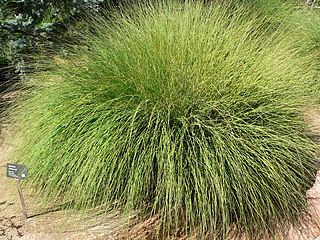
Stipa is a genus of around 300 large perennial hermaphroditic grasses collectively known as feather grass, needle grass, and spear grass. They are placed in the subfamily Pooideae and the tribe Stipeae, which also contains many species formerly assigned to Stipa, which have since been reclassified into new genera.

Calamagrostis is a genus of flowering plants in the grass family Poaceae, with about 260 species that occur mainly in temperate regions of the globe. Towards equatorial latitudes, species of Calamagrostis generally occur at higher elevations. These tufted perennials usually have hairless narrow leaves. The ligules are usually blunt. The inflorescence forms a panicle. Some may be reed-like.

Festuca (fescue) is a genus of flowering plants belonging to the grass family Poaceae. They are evergreen or herbaceous perennial tufted grasses with a height range of 10–200 cm (4–79 in) and a cosmopolitan distribution, occurring on every continent except Antarctica. The genus is closely related to ryegrass (Lolium), and recent evidence from phylogenetic studies using DNA sequencing of plant mitochondrial DNA shows that the genus lacks monophyly. As a result, plant taxonomists have moved several species, including the forage grasses tall fescue and meadow fescue, from the genus Festuca into the genus Lolium, or alternatively into the segregate genus Schedonorus.

Panicum (panicgrass) is a large genus of about 450 species of Poaceae grasses native throughout the tropical regions of the world, with a few species extending into the northern temperate zone. They are often large, annual or perennial grasses, growing to 1–3 m (3–10 ft) tall.

Bouteloua is a genus of plants in the grass family. Members of the genus are commonly known as grama grass.

Muhlenbergia is a genus of plants in the grass family.

Elymus is a genus of perennial plants with approximately 150 species in the grass family, related to rye, wheat, and other widely grown cereal grains.

Melica is a genus of perennial grasses known generally as melic or melic grass. They are found in most temperate regions of the world.

Hesperostipa is a genus of grasses in the family Poaceae. Members of the genus are commonly known as needle-and-thread grass or needlegrass.









